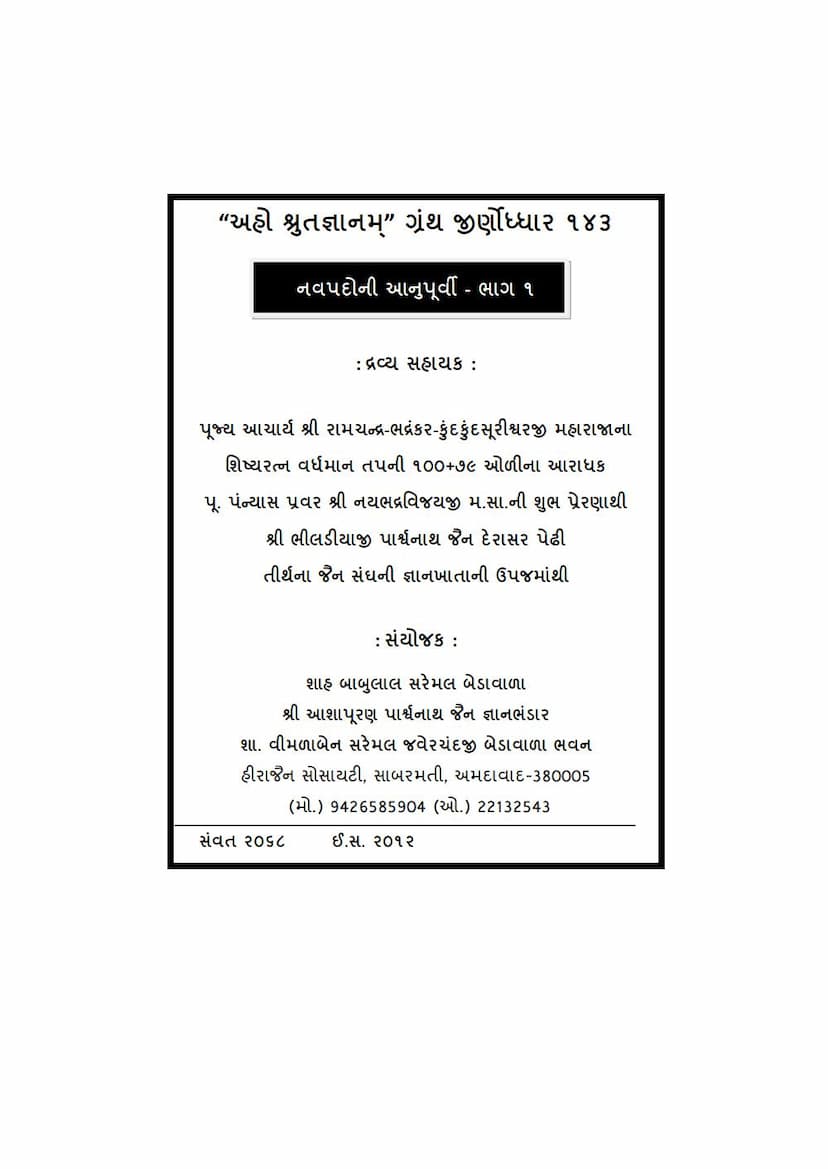Anupurvi Part 01
Added to library: September 1, 2025

Summary
This document appears to be the first part of a larger Jain religious text titled "Anupurvi Part 01" authored by Somvijay and published by Babubhai Savchand Shah. The catalog link provided is https://jainqq.org/explore/009116/.
The initial pages (1-2) are introductory, acknowledging the inspiration of respected Jain scholars and the financial contribution from the Shree Bhiladiya Parshvanath Jain Derasar Pedhi for the publication.
Pages 3-8 list a collection of scanned and digitized books, compiled for the "Aho Shrutgyanam Granth Jirnoddhar" project from Sambat 2065 (2009) to Sambat 2068 (2012). This list includes a variety of Jain texts covering topics like Nandi Sutra, Uttaradhyayan Sutra, Arhat Gita, Yuktigranth, Manatung Shastra, Shilpa Shastra, Vastu Shastra, Jyotish, Nyaya, and Vyakaran, among others. The list indicates the book title, author/commentator/editor, page count, and language.
Pages 10-11 delve into the concept of "Anupurvi" (sequence) in Jainism, particularly in relation to the Navpad (nine supreme entities). It explains that the calculation of permutations for these sequences leads to a specific number of combinations. For example, with two entities, there are 2! = 2 sequences. For nine entities, the number of sequences is 9! = 362,880, but due to specific Jain mathematical principles (likely related to the nature of these entities), the actual number of unique sequences considered in this context is 362. The text elaborates on the concept of Anupurvi, Purva, Panu, and Anupurvi, emphasizing the logical arrangement and counting of these elements.
The subsequent pages, starting from page 12, appear to be the main body of the text, which is titled "Navpadoni Anupurvi - Bhag 1" (The Sequential Arrangement of the Nine Entities - Part 1). The author, Muni Shri Samvijayji Maharaj, explains his motivation for preparing this work, stemming from a desire to understand and present the intricacies of the Navpad Anupurvi. He mentions receiving inspiration from Acharya Shri Vijayamatsurishwarji Maharaj and guidance from Upadhyay Shri Vijayji Ganivar. The author details the methodology used in preparing the text, which involves specific columns and the sequential presentation of information. The text illustrates how to understand the sequence of the Navpad, using the example of the Namokar mantra, and then extends this to other sequences of the Navpad.
The later pages, particularly from page 13 onwards, seem to contain the detailed exposition of the Anupurvi, likely showing the different permutations and combinations of the ninefold entities within the Jain philosophical framework. The large amount of repetitive numerical and character-based data throughout these pages indicates a systematic and potentially complex enumeration or calculation related to the Anupurvi concept.
In essence, "Anupurvi Part 01" is a scholarly work that aims to systematically explore and explain the concept of sequential arrangements of the nine supreme entities in Jainism, providing a foundational understanding of this complex topic through detailed enumeration and referencing a vast collection of Jain literature. The introductory pages highlight the collaborative effort and scholarly support behind this publication, while the bulk of the text seems dedicated to the detailed exploration of the Anupurvi itself.